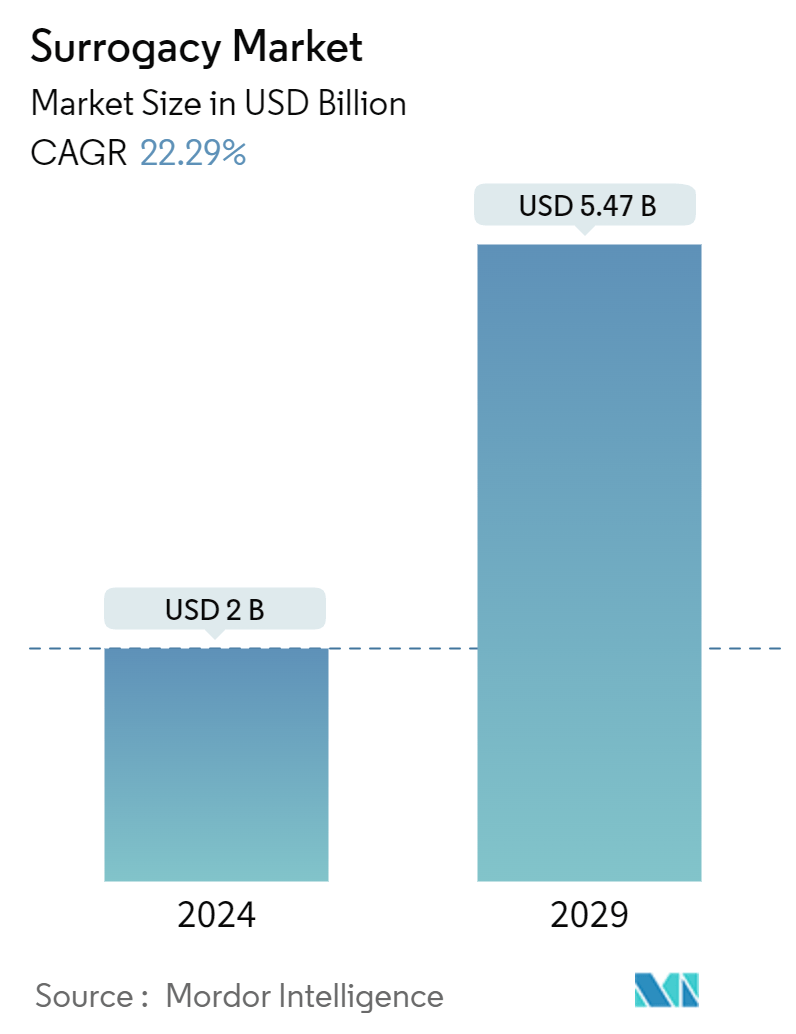Market Size of Surrogacy Industry

| Study Period | 2021 - 2029 |
| Market Size (2024) | USD 2 Billion |
| Market Size (2029) | USD 5.47 Billion |
| CAGR (2024 - 2029) | 22.29 % |
| Fastest Growing Market | Asia Pacific |
| Largest Market | North America |
Major Players
*Disclaimer: Major Players sorted in no particular order |
Surrogacy Market Analysis
The Surrogacy Market size is estimated at USD 2 billion in 2024, and is expected to reach USD 5.47 billion by 2029, growing at a CAGR of 22.29% during the forecast period (2024-2029).
Factors such as the increasing number of infertility cases globally, the sedentary lifestyle of people, the growing number of fertility clinics, and rising awareness about assisted reproductive technology, such as in-vitro fertilization (IVF) and surrogacy, are expected to boost the market growth over the forecast period.
Infertility is becoming an increasing challenge owing to multiple factors such as environment, genetics, age, and comorbidities that have been associated with impaired reproductive function. For instance, according to the data published by the World Health Organization in April 2023, it was observed that about 17.5% of the adult population, roughly 1 in 6 worldwide, may experience infertility, showing the urgent need to increase access to affordable, high-quality fertility care for those in need. Additionally, an article published in Cell Journal in May 2022 stated that male infertility is an increasing and serious medical concern that affects approximately half of infertile couples worldwide. Thus, the growing number of infertility cases has increased the demand for fertility procedures using assisted reproductive technology (ART), such as surrogacy, which, in turn, is anticipated to fuel the market growth over the forecast period.
Additionally, demographic changes and ongoing lifestyle disorders like obesity, anxiety, and stress cause delayed childbearing. Some of the prevalent causes of infertility are imbalances in hormones, sexually transmitted diseases, and polycystic ovary syndrome (PCOS). For instance, in an article published by Gynaecology and Obstetrics in January 2023, it was highlighted that individuals dealing with obesity encounter heightened challenges in accessing fertility treatments and realizing successful pregnancies. Moreover, the significant impact of obesity on implantation and live birth rates often results in infertility. Consequently, the prevalence of obesity among women increases the likelihood of turning to surrogacy, which is expected to fuel the market growth over the forecast period.
Furthermore, the rising number of fertility clinics globally, owing to the increasing fertility issues among the population, is expected to propel the demand for fertility treatments such as surrogacy. For instance, in May 2023, Generation Prime launched its first two fertility clinics in Bangkok and Kuala Lumpur. The clinics provide initial consultations and include egg and sperm freezing, diagnosis, testing, IVF, and surrogacy. Also, Generation Prime plans to open a total of 15 clinics in Thailand, Malaysia, and Singapore. Similarly, in December 2022, Kindbody launched a state-of-the-art clinic and in-vitro fertilization (IVF) lab in Dallas, Texas, United States. This launch assists Kindbody in meeting the increasing demand for world-class fertility care.
Therefore, the market is anticipated to grow over the forecast period due to the aforementioned factors, such as the high burden of infertility, increasing IVF awareness campaigns, and the growing number of IVF facilities and products. However, the complications associated with in-vitro fertilization, as well as social stigma and ethical and legal issues associated with it, may hinder the growth of the market over the forecast period.
Surrogacy Industry Segmentation
Surrogacy is a method of assisted reproductive technology in which the surrogate carries a baby and takes care of the baby until birth. In this procedure, the embryo is developed through an in-vitro fertilization procedure (IVF) using the eggs and sperm of the intended parents. The embryo is then transferred to the surrogate mother.
The surrogacy market is segmented by type, technology, service provider, and geography. By type, the market is segmented into gestational surrogacy and traditional surrogacy. By technology, the market is segmented into IVF with intracytoplasmic sperm injection (ICSI), IVF without intracytoplasmic sperm injection (ICSI), and intrauterine insemination (IUI). By service provider, the market is segmented into hospitals and fertility centers. By geography, the market is segmented into North America, Europe, Asia-Pacific, Middle East and Africa, and South America. For each segment, the market size and forecast are provided in terms of value (USD).
| By Type | |
| Gestational Surrogacy | |
| Traditional Surrogacy |
| By Technology | |
| IVF with Intracytoplasmic Sperm Injection (ICSI) | |
| IVF without Intracytoplasmic Sperm Injection (ICSI) | |
| Intrauterine Insemination (IUI) |
| By Service Provider | |
| Hospitals | |
| Fertility Centers |
| Geography | ||||||||
| ||||||||
| ||||||||
| ||||||||
| ||||||||
|
Surrogacy Market Size Summary
The surrogacy market is poised for significant growth, driven by an increasing prevalence of infertility globally, which is influenced by factors such as environmental changes, genetics, and lifestyle disorders. The rising awareness and acceptance of assisted reproductive technologies, including in-vitro fertilization (IVF) and surrogacy, are further propelling market expansion. The growing number of fertility clinics and advancements in reproductive technologies are also contributing to the market's upward trajectory. Despite the potential challenges posed by social stigma and ethical concerns, the demand for surrogacy is expected to rise, supported by government initiatives and regulatory frameworks aimed at facilitating access to fertility treatments.
North America is anticipated to hold a substantial share of the surrogacy market, bolstered by a rising number of infertility cases and favorable regulatory reforms. The region's market growth is further supported by the presence of leading fertility clinics and the increasing adoption of surrogacy programs. Strategic activities such as acquisitions and collaborations among fertility providers are enhancing the availability of surrogacy procedures. The introduction of new fertility centers and platforms is also expected to drive market growth, as they offer comprehensive services and support for individuals seeking surrogacy options. Key players in the market are actively engaging in strategic initiatives to strengthen their presence and cater to the growing demand for surrogacy services.
Surrogacy Market Size - Table of Contents
-
1. MARKET DYNAMICS
-
1.1 Market Overview
-
1.2 Market Drivers
-
1.2.1 Increasing Number of Infertility Cases Globally Coupled with Sedentary Lifestyle
-
1.2.2 Growing Number of Fertility Clinics
-
1.2.3 Increasing Awareness About Assisted Reproductive Technology Such as IVF and Surrogacy
-
-
1.3 Market Restraints
-
1.3.1 Stringent Regulations About Commercial Surrogacy
-
1.3.2 High Cost Involved in Surrogacy Procedure
-
-
1.4 Porter's Five Force Analysis
-
1.4.1 Threat of New Entrants
-
1.4.2 Bargaining Power of Buyers/Consumers
-
1.4.3 Bargaining Power of Suppliers
-
1.4.4 Threat of Substitute Products
-
1.4.5 Intensity of Competitive Rivalry
-
-
-
2. MARKET SEGMENTATION (Market Size by Value - USD)
-
2.1 By Type
-
2.1.1 Gestational Surrogacy
-
2.1.2 Traditional Surrogacy
-
-
2.2 By Technology
-
2.2.1 IVF with Intracytoplasmic Sperm Injection (ICSI)
-
2.2.2 IVF without Intracytoplasmic Sperm Injection (ICSI)
-
2.2.3 Intrauterine Insemination (IUI)
-
-
2.3 By Service Provider
-
2.3.1 Hospitals
-
2.3.2 Fertility Centers
-
-
2.4 Geography
-
2.4.1 North America
-
2.4.1.1 United States
-
2.4.1.2 Canada
-
2.4.1.3 Mexico
-
-
2.4.2 Europe
-
2.4.2.1 Germany
-
2.4.2.2 United Kingdom
-
2.4.2.3 France
-
2.4.2.4 Italy
-
2.4.2.5 Spain
-
2.4.2.6 Rest of Europe
-
-
2.4.3 Asia-Pacific
-
2.4.3.1 China
-
2.4.3.2 Japan
-
2.4.3.3 India
-
2.4.3.4 Australia
-
2.4.3.5 South Korea
-
2.4.3.6 Rest of Asia-Pacific
-
-
2.4.4 Middle East and Africa
-
2.4.4.1 GCC
-
2.4.4.2 South Africa
-
2.4.4.3 Rest of Middle East and Africa
-
-
2.4.5 South America
-
2.4.5.1 Brazil
-
2.4.5.2 Argentina
-
2.4.5.3 Rest of South America
-
-
-
Surrogacy Market Size FAQs
How big is the Surrogacy Market?
The Surrogacy Market size is expected to reach USD 2 billion in 2024 and grow at a CAGR of 22.29% to reach USD 5.47 billion by 2029.
What is the current Surrogacy Market size?
In 2024, the Surrogacy Market size is expected to reach USD 2 billion.

